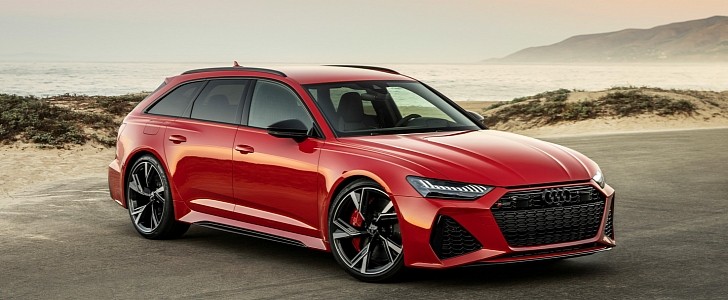The 2021 Audi RS6 offers two suspension system choices. The standard choice is an adaptive air suspension, while the sportier version features fixed coil springs and adjustable dampers.
The high-performance RS models developed by Audi Sport have been highlighting the newest, most advanced technologies of the German carmaker ever since 1994, when the RS2 Avant was introduced.
Twenty-five years after the release of the first RS model, Audi introduced the fourth generation RS6, which, just like the original RS2, is only available in the Avant station wagon body style.
It is powered by a 4.0-liter TFSI twin-turbo V8 that produces 591 hp (442 kW; 600 PS), a 40 hp increase compared to the previous generation. It is coupled to the legendary ZF 8HP90 eight-speed automatic transmission.
A new feature for the current generation is the use of a mild-hybrid system that consists of a 48-volt Starter-Generator, which can aid the gasoline engine and help recover up to 12 kW of power during light deceleration.
The new model offers a standard RS-tuned adaptive air suspension that controls damping electronically. It features new air spring damper modules that have an increased spring rate of up to 50% compared to the previous model.
The suspension can be set to several modes that include automatic level control. The electronic chassis platform (ECP) system manages the way the damper modules work by automatically adjusting them to road conditions, driving style, and the selected drive mode.
When selecting auto, comfort or efficiency modes, the RS6 will sit 20 millimeters (0.8 in) lower than a standard Audi A6 Avant. At speeds of 120 km/h (75 mph) and above, the air suspension will automatically lower the car by an additional 10 millimeters (0.4 in).
If dynamic mode is selected, the RS6 will permanently drop to the lowest setting, but on poor road surfaces the RS adaptive air suspension will raise the car 20 millimeters (0.8 in) above its normal level and maintain this height at very low speeds.
The excellent RS adaptive air suspension offers a wide range of modes that give the driver a choice between long-distance comfort and maximum performance. But remember, this is the standard suspension on the RS6.
The optional RS sport suspension with Dynamic Ride Control (DRC) is available as a sportier alternative. It is a lighter and more responsive system that gives the car better grip at high speeds and improves handling.
The integrated DRC offers pitch and roll stabilization using advanced three-way adjustable dampers and steel coil springs that counter the vehicle’s body movements instantaneously without the use of any electronics.
The dampers are connected to a central valve via two separate oil lines. When the car is steering into a tight corner an oil flow is generated between the diagonally opposite dampers, which create additional damping force. In other words, when one side is cushioned damping is altered so that roll and pitch movements are almost entirely eliminated. The result is increased stability and grip, especially in very tight corners.
Choosing this suspension package will turn the capable RS6 into a track-ready beast that can corner and handle just as well as a smaller hot hatch. That said, it is obviously a lot less comfortable.
The new RS6 Avant is sold in the U.S. for the first time, joining the RS7 Sportback on American roads. Pricing for the beautiful model starts at $110,045.
Twenty-five years after the release of the first RS model, Audi introduced the fourth generation RS6, which, just like the original RS2, is only available in the Avant station wagon body style.
It is powered by a 4.0-liter TFSI twin-turbo V8 that produces 591 hp (442 kW; 600 PS), a 40 hp increase compared to the previous generation. It is coupled to the legendary ZF 8HP90 eight-speed automatic transmission.
A new feature for the current generation is the use of a mild-hybrid system that consists of a 48-volt Starter-Generator, which can aid the gasoline engine and help recover up to 12 kW of power during light deceleration.
The new model offers a standard RS-tuned adaptive air suspension that controls damping electronically. It features new air spring damper modules that have an increased spring rate of up to 50% compared to the previous model.
When selecting auto, comfort or efficiency modes, the RS6 will sit 20 millimeters (0.8 in) lower than a standard Audi A6 Avant. At speeds of 120 km/h (75 mph) and above, the air suspension will automatically lower the car by an additional 10 millimeters (0.4 in).
If dynamic mode is selected, the RS6 will permanently drop to the lowest setting, but on poor road surfaces the RS adaptive air suspension will raise the car 20 millimeters (0.8 in) above its normal level and maintain this height at very low speeds.
The excellent RS adaptive air suspension offers a wide range of modes that give the driver a choice between long-distance comfort and maximum performance. But remember, this is the standard suspension on the RS6.
The optional RS sport suspension with Dynamic Ride Control (DRC) is available as a sportier alternative. It is a lighter and more responsive system that gives the car better grip at high speeds and improves handling.
The dampers are connected to a central valve via two separate oil lines. When the car is steering into a tight corner an oil flow is generated between the diagonally opposite dampers, which create additional damping force. In other words, when one side is cushioned damping is altered so that roll and pitch movements are almost entirely eliminated. The result is increased stability and grip, especially in very tight corners.
Choosing this suspension package will turn the capable RS6 into a track-ready beast that can corner and handle just as well as a smaller hot hatch. That said, it is obviously a lot less comfortable.
The new RS6 Avant is sold in the U.S. for the first time, joining the RS7 Sportback on American roads. Pricing for the beautiful model starts at $110,045.










